yogabook / props
props
The most common tools used in definite yoga are described here, along with their properties that enable their effects and their use.
bolster / cushion . blanket . window sill . belt . block . dumbbell / weight plate . mat and patch made of mat . tube . shoulder stand plate . mirror . stick . chair/bench . supporter . wall
Block
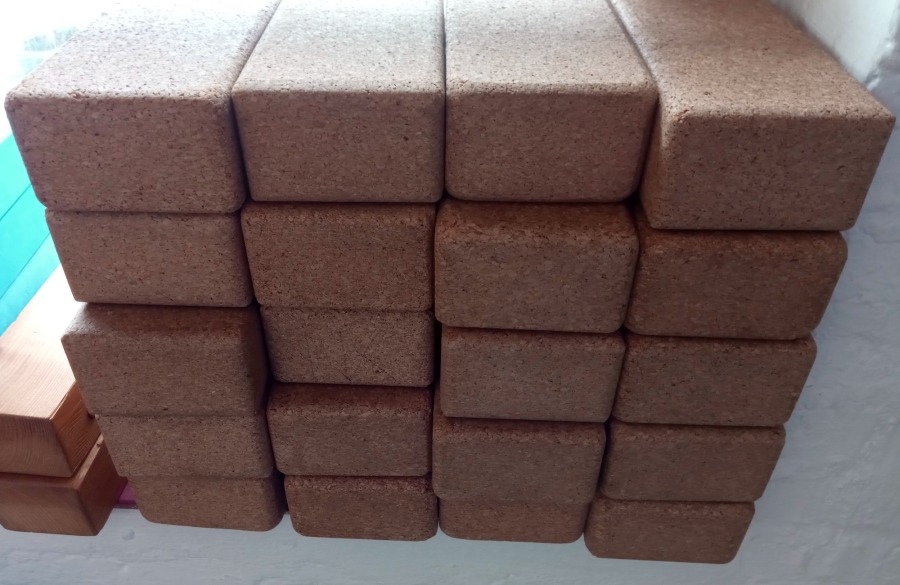
Purpose
Elevation, resistance, mechanical blocking, imparting a moderate weight, increasing the level of difficulty
Explanation
There are blocks made of different materials (e.g. cork, wood, foam). Advantages of cork: warm, soft and stable at the same time, certain weight, pleasant edges. A block should never be placed under the lumbar vertebrae in the supine position, as this prevents the elimination of the hollow back. Blocks are used to raise a support so that a part of the body can be supported on it, furthermore as a (reasonably comfortable) resistance against which to press. They can also mechanically block unwanted movements. They are used to add a moderate weight or increase the level of difficulty. We have been using cork blocks with three different edge dimensions for a long time with great satisfaction, which can be adapted to many requirements thanks to the three heights that can be achieved per block. In some cases, two or more blocks can also be used one behind the other or on top of each other. Depending on the application, a patch may be required between two blocks to prevent them from slipping against each other. To illustrate this effect, two blocks can be placed on top of each other, first without and then with a patch of mat.
and then try to move them against each other from different directions.
The categorisation given below is probably neither complete, nor is it disjunctive; some uses of blocks fall into several categories.
Examples
Elevation, „lengthening“ of a limb
In postures such as parivrtta trikonasana, ardha chandrasana, parivrtta ardha chandrasana, parsvakonasana or table pose, blocks can „bring the floor closer“, i.e. the stable surface on which the fingertips are placed almost weightlessly or body weight is supported. Another type of use is blocks under the hands in tolasana and related arm balances, which are particularly helpful or necessary for seated giants, i.e. when the arms are „too short“ in relation to the upper body and therefore the pelvis cannot be lifted off the floor in tolasana, for example. The transition from head down dog pose to dandasana, in which the legs swing through the arms, which is popular in vinyasa, is hardly possible for seated giants without tricks. Blocks are also a good relief here. Another example is halasana performed with the feet on a block, in which the block – as longer feet would do – minimises the mobility requirements on the spine that need to be met in order to be able to straighten the back or extend it to a certain degree. In supta virasana, they serve to support the back or the head or both in order to „bring the floor up“ a little if mobility is less favourable.
Moderate weight
These include, for example, the variations of trikonasana and parivrtta trikonasana, in which the block is held in the hand of the raised arm. Although it does not represent a significant weight, it adds a certain amount of awareness to the movement of the arm at the end of the natural lever arm. This applies in a similar way to the second warrior pose or parsvakonasana with a block in the hand, even though the movement of the arm is completely different
Aggravation / build-up of tension
The best example here is probably upavista konasana with a block, in which the block also represents an additional weight to be lifted, but the main effect is likely to result from the fact that you have to press against the side of the block to prevent it from falling. This option of using the block therefore falls less into the category of mechanical blocking, as the inward(medial) movement of the arms is not an evasive movement but an additional requirement. The use of blocks to practise samakonasana as the limit of upavista konasana on the wall also falls into the category of aggravation. It is often difficult to lift the pelvis forwards if you already have very good flexibility by pressing one hand in front of and one behind the pelvis on the floor in order to lift the pelvis and move it towards the wall, simply because there is not enough space between the pelvis and the wall. Blocks between the feet and the wall then help. They not only allow you to approach the 180° angle with ease, but also to practise angles of more than 180°. The use of the block between the thighs in the two-legged handstand lift is different again. Here too, continuous pressure must be built up against the block to prevent it from falling. However, this serves to synchronise the movement of the legs when assuming the pose and not to build up tension permanently as in upavista konasana with a block. A variation of uttanasana on blocks combines the principle of intensification with the principle of the fingerboard: a platform is constructed from several layers of blocks, leaving a small area on both sides of the lowest level so that the hands can pull on the second lowest layer.
Increasing the level of difficulty/intensification
The situation with baddha konasana with a block is slightly different to upavista konasana with a block. Here it is less about blocking an evasive movement, as mentioned below, and more about changing the geometry of the pose for greater effectiveness: the greater the distance between the feet, the more intensively certain adductors can be stretched. Furthermore, the block or blocks can also be used under the feet instead of between them, which in turn changes the posture in a slightly different way and makes it a good preparatory exercise for the root tuber. Another pose that demonstrates this principle excellently is uttanasana with the ball of the foot on a block, which forces the foot into a clear dorsal flexion and thus creates a very useful stretch in the gastrocnemius. Shoulder strength training looks completely different in the handstand, when a block is alternately climbed onto and off a block with one hand. The normal static handstand variation“on blocks“, on the other hand, is characterised by the greater momentum required, as the body mass has to be accelerated further upwards compared to the starting position. The increased back extension also falls into this category if the hands are not pressed directly onto the wall but onto blocks, in which case they act as spacers.
Mechanical blocking of movements
A classic example in this category is the dog elbow stance. Significant evasive moments occur here, which want to turn the widely exorotated upper arms into the shoulder joint. If no intervention is made, this would result in the elbows moving outwards and the forearms moving inwards(medially) and the hands pushing towards each other. This movement can easily be blocked with the help of a block so that the effect of the posture is essentially fully maintained. However, despite the excellent function of this application, it should be noted that the moments or forces absorbed by the block are only partially converted into lateral pressure against it. Part of it acts on the elbow and also pushes it outwards.
Limiting a movement to prevent damage or pain
Classic examples here are the postures with one or two lotusor baddha konasana leg(s), in which the sinking of the thigh and knee is reduced to a level at which there is still no pain in the knee, which occurs without the use of the block at maximum possible sinking. Of course, this reduces the exorcised lateral abduction and the effectiveness of the posture, which suggests switching to other, synergistic postures such as the 3rd hip opening, in which discomfort in the bent knee is virtually unknown. However, the effect is often sufficient if the posture is held for longer. The block can also be used in the baddha konasana forward bend to prevent pain from occurring due to the knees sinking a long way. In this case, however, this hardly affects the hip flexion and the stretching of the monoarticular hip extensors. This category also includes the blocks under the heels in the head-down dog position if there is an extreme stretching sensation in the calves or if they are injured, e.g. due to a pulled muscle. There is also a tradition for people who can hyperextend the knee joints to place a block at a 90° angle against the lower leg in trikonasana, which safely prevents hyperextension. In principle, this works quite reliably, but from the point of view of definite yoga, this is not a superior solution, but merely symptom suppression, as it avoids the need to develop strength and body awareness in order to control the knee in all situations and protect it from hyperextension. As a rule, weaknesses in the quadriceps or the ischiocrural group are among the causes of knee joint hyperextension that need to be eliminated. The variant of bending the knee joint far and pressing the upper body with the flank as far as possible onto the thigh in order to attempt to straighten the knee from there is a more interesting choice if the ischiocrural group and gracilis are not exceptionally flexible: the mobility restrictions generally prevent the knee from being straightened and therefore, of course, also prevent hyperextension very reliably. This variation can also produce an extremely intense stretching effect, which is usually far beyond hyperextension and can be scaled as required. In bridge (urdhva dhanurasana), they are used for relief when the wrists and no more than these are placed on blocks. This allows the hand to move freely downwards and the wrist is not forced into an incompatible dorsiflexion.
Seat pad
in some postures in which sitting upright is part of the pose, such as half gomukhasana, half garudasana, lotus, half lotus, dandasana, maricyasana 1, maricyasana 3 and upavista konasana, restrictions in the mobility of the hip extensors can make the pose more difficult to perform, by tilting the pelvis backwards in relation to the vertical with or without a tendency to spasm in the thigh and therefore shifting the centre of gravity to an unfavourable area behind the ischial tuberosities or to their rear end as well as simply increasing the necessary work of the back muscles to a level that can no longer be sustained. If the pose involves one or two straight legs with a vertical pelvis, such as dandasana, there is often a tendency for the rectus femoris to spasm because the ischiocrural group tilts the pelvis backwards and this muscle has to help hold it upright. As it works in flexion in the hips of usually 90° in the area of or close to its active insufficiency, it has a more or less clear tendency to spasm. If the posture involves an upright pelvis but not an extended leg but a bent leg with the foot up, such as maricyasana 1 and maricyasana 3, the monoarticular hip extensors and the pomus muscles, if their mobility is restricted, can tilt the pelvis backwards and thus also cause the back muscles to have to work excessively hard. In all these cases, the situation is significantly alleviated if the buttocks are raised. In the case of the extended leg, the flexion angle in the hip joint is somewhat more moderate due to the block; in the case of a bent leg with the foot upright, the same applies, except that the relief does not affect the ischiocrural group but the monoarticular hip extensors.
Building up pressure on the tissue/muscles to relieve tension (e.g. with )
A block is rarely used to apply pressure to muscles in order to relax them a little. This approach can sometimes be successful, for example, for nuchal (neck) headaches by applying pressure to the muscles on the lower edge of the occipital bone.
Visualisation
This includes all postures that hold a block between the thighs, the position or movement of which makes the rotation of the thighs clear: the inward rotation of the thighs moves it dorsally, the outward rotation frontally. This applies to many postures with closed or hip-width feet, from tadasana to uttanasana and handstand.
Fingerboard
Here we think first and foremost of poses such as pascimottanasana, in which the block is gripped with both hands at the sides and pressed against the sole of the foot. In addition to „making things more difficult“ and „lengthening the limb“ (see categories above), the block also serves as a fingerboard for the hands.
Support
This category includes, for example, the block placed under the back and possibly also under the head or packing blocks in poses such as supta virasana. The head does not contribute significantly to the posture and its position would be largely irrelevant (apart from the pull that its weight exerts on the upper body), but the neck muscles are often unable to hold it for as long as the posture can be performed. This is particularly true in cases where supta virasana cannot yet be held well.
Producing a specific geometry
A classic example of this is setu bandha sarvangasana on a block, the execution and effectiveness of which differs significantly from the other variations. The sacrum resting on a block is intended to create the conditions for stretching the hip flexors over a certain period of time together with stretching the knees and lowering the thighs. This variation therefore differs from far more active variations, in which the quadriceps are responsible for lifting the pelvis and the resulting stretch in addition to the pomus muscles. Similarly, kapotasana performed on blocks is a less active, more calm and passive stretching pose. In a way, lying on a block under the thoracic spine also falls into this category. Here, the block allows the shoulder blades to sink with the arms next to the spine in a way that would not be possible in a purely supine position.
Finding the maximum of a convex shape
There are few examples of this, a well-known one is finding the highest point of the head in preparation for the headstand and then standing on the area THEREFORE.
Marking
A very simple application of the block is for marking. This can be helpful in right-angled handstand, right-angled elbow stand and other postures in which a distance needs to be marked, such as a distance from the wall.
Dimension
This is another category of its own. Blocks can be used to estimate or compare distances or heights, for example in baddha konasana or upavista konasana in supine position, when the distance from the floor needs to be measured or compared and no centimetre measure or similar is available. The block then allows a sufficiently accurate assessment of whether there are side discrepancies in mobility.
Promotion of introversion (damping)
The example par excellence is the block placed on the forehead in savasana, which promotes introversion. Whether this is due more to the pressure on the forehead, the slight darkening of the eyes or the physical mass that lies on the receptive aspect of the sixth chakra is open to debate.
Blanket
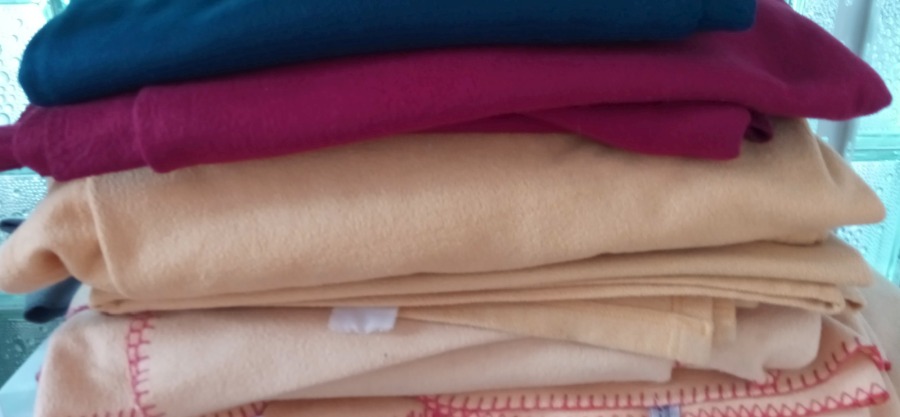
Purpose
Imparting softness, comfortable elevation, reduction of friction
Explanation
Blankets are standard aids wherever softness is required because a support is too hard or pressure is felt. Sometimes they are also used as elevation. Blankets are flexible to use between single layer and multiple folds. In some applications, however, it should be noted that blankets do not provide good friction, so it may be better to use a multi-folded mat, a pack of patches or at least an overlay in the form of a patch on the blanket used
Examples
Softener
We find them in many postures in which the contact of the body with the floor would otherwise be uncomfortably hard, e.g. supta virasana under the knees or especially the feet, jathara parivartanasana under the pelvis, which rolls onto the lateral iliac crest in the posture, which often leads to an unpleasant sensation of pressure, as there is little musculature there to cushion this. In postures such as dog elbow stand, elbow stand and right-angled elbow stand, blankets are used to cushion the ulna if it would otherwise press uncomfortably hard on the floor. However, due to the poor friction of the skin or clothing on the blankets and the possibility of the layers of the blanket shifting against each other, an additional belt must be placed around the forearms near the elbows to prevent the elbows from drifting apart on the blanket. Baddha konasana is another example, with a potentially uncomfortably intense pressure of the outer edge of the foot on the floor. As before, although the blanket can provide sufficient softness, it can cause the feet to slide away from the pelvis. Here too, a belt would be needed to prevent this by placing it around the pelvis, through the slats and around the outer edges of the feet. In some cases, it may be worth considering whether a pack of patches would do as good a job as a blanket and belt, especially as installation is quicker. In other postures, it is the spine or individual areas of the spine that should be softer, in particular the 7th cervical vertebra C7 and its surrounding area in postures such as karnapidasana, shoulderstand and halasana as well as their relatives. When practising dynamic transitions from these poses to seated forward bends such as pascimottanasana and similar poses, a blanket or mat under the pelvis can also prevent the pelvis from hitting the floor uncomfortably hard, especially for less experienced performers and those with reduced flexion capacity of the lumbar spine.
Increase
In a similar way that a block is used to elevate a sitting posture, e.g. to help the pelvis to straighten more when sitting because the ischiocrural group is relieved by a more moderate flexion angle in the hip joint, blankets can also be folded in a sufficient number of layers for the same purpose. If a blanket is used as an elevation in shoulderstand, the same applies as for the elbow poses and baddha konasana mentioned above, only here again it is the elbows that drift apart, making an additional belt necessary. In supta virasana, the blanket can be used to gently limit the movement of the knees towards the floor when a supporter presses them down. In contrast to a block or a mat, a folded blanket with its compressibility offers better progression and a comfortable support surface for the knees.
Warming/preventing cooling
Depending on the constitution and intensity of the exercise, the body tends to perspire more or less and develops more or less heat through muscular work. The body cools itself through the evaporative cooling of perspiration (= increased heat release), especially during intensive muscular work, in order not to overheat. This is especially true for people who have already done a lot of endurance sports. The body has become accustomed to the need to dissipate heat through sweating and sometimes begins to do so even during light exertion. There is also an increased tendency to perspire during the „menopause“, especially in women, but also in men. This mechanism of cooling through perspiration continues to have an effect for different lengths of time, even if the participant is already in a resting phase afterwards; thermoregulation works differently for each individual. There are many people who have hardly ever practised endurance sports, who tend to sweat very little and who, even during intense and prolonged physical activity, hardly sweat out a fraction of what an endurance athlete sometimes sweats out during shorter moderate physical exertion. Due to the significant differences, it may be advisable for some people to cover their body with a blanket after intensive exercise during the subsequent relaxation period so that they do not lose too much heat, which can lead to colds in some people. This applies all the more after strenuous postures such as standing postures with bent legs, backbends, inversion postures and, above all, dynamic exercises. It is also important to remember to close the windows during savasana, for example (at least when the outside temperature is not too high), so that this effect is not exacerbated by draughts (and the associated wind-chill effect).
Reduction of friction
In a similar way to how the mat and patches improve friction, the blanket can be used for the opposite purpose. A classic application is certainly adho mukha supta baddha konasana, which requires the knees to slide outwards as far as possible. On the other hand, a blanket under the hands is beneficial in downward dog if you want to perform the variation in which the hands are pulled towards the feet instead of the normal variation in which the hands are pushed away from the feet. The blanket reliably prevents the trained, undesirable work of pushing the hands forwards.
Promotion of introversion (damping)
Similar to the block and much easier to place than the block, the blanket can also be placed on the area of the 6th chakra to promote introversion.
Belt
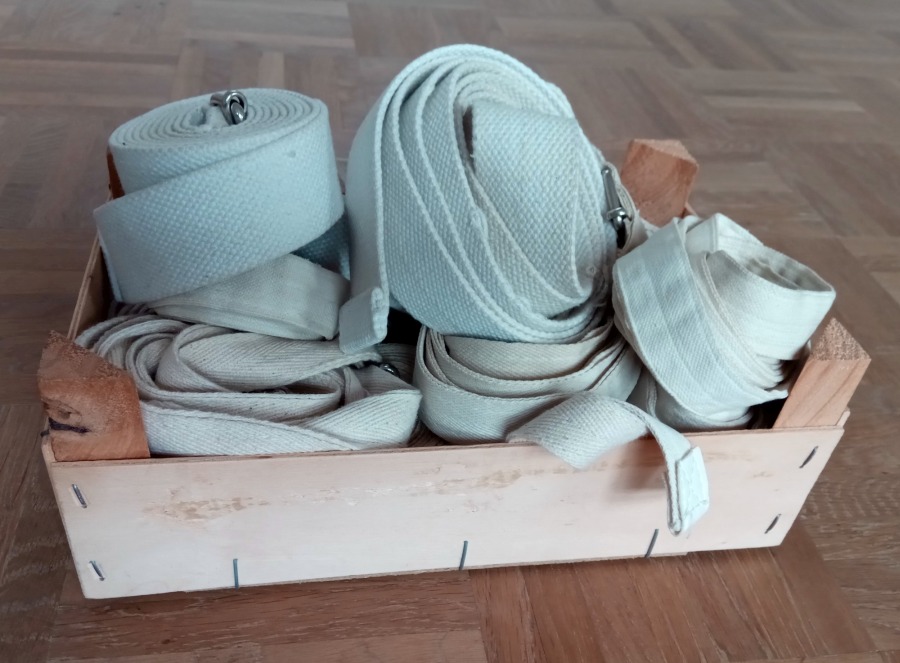
Purpose
Limitation of movement, fixation, extension, generation of rotation
Explanation
Belts must be threaded correctly: the free end of the belt is passed through the belt-side end of the fastener and then through the other end. Avoid twisting! Turn the buckle round to open it. The buckle should not press into the flesh!
Examples
Fixation
An obvious example is baddha konasana, in which the belt is placed around the sacrum through the groin and around the outer edges of the feet to prevent them from slipping forwards. In supta virasana, the belt is often used to prevent the thighs from drifting apart. It is possible to wrap the belt around the entire leg or only around the thighs. The latter maintains the ability to jump down from supta virasana into dog head. The same category includes absorbing unwanted forces, such as when the elbows slip apart in dog elbowstand. A completely different application in the area of fixation is the use of the belt to attach a small dumbbell to one foot in lying upavista konasana leaning against the wall so that side discrepancies in mobility can be addressed. The same applies to baddha kon asana if the thighs are still at such an angle that a dumbbell placed on them near the knees would slip off.
Extension / bridging of distance
This is probably one of the most common uses of belts. Especially in forward bending movements with limited mobility of the ischiocrural group, a belt quickly becomes necessary due to the greater length of the legs compared to the arms. The belt is usually placed around one or two soles of the feet. It is advisable to place it relatively close to the heel so that the leverage effect in the direction of plantar flexion does not cause additional significant stretching in the gastrocnemius if this is not expressly desired. Examples are: pascimottanasana, kapotasana, hasta padangusthasana, supta padangusthasana, supta krouncasana.
Pull function
The belt can be used to exert traction on a body structure, even by a supporter. Examples include Dog position head down as a partner exercise: the belt is fixed to the thighs, the performer tilts more in the hips and, above all, stretches better from the shoulders)
Rotation function
A belt can be used to twist a body part if it is pulled tight enough and pulled more at one end, or if the direction of pull is approximately tangential to the limb. Examples include: trikonasana and related postures with the thigh to be turned out, in which a belt is placed around the thigh so that its end lies on top (frontal side) of the thigh; it is then pulled laterally.
Making tension tangible
If a belt is placed around an extremity in a posture where the muscles have to work (at least partially) or be tensed, the cross-section of the extremity can change from more or less round to slightly more elongated due to the tensing of the muscles, which leads to a change in circumference and makes the tension perceptible in the form of the pressure of a reasonably tight belt.
Tangible resistance
In jalandara bandha, the rolled-up belt provides a comfortable resistance against which pressing gently gives good feedback that the bandha is being maintained.
Mat and patch made from mat

Purpose
Slip resistance, elevation, limited compressibility and softness
Explanation
Mats are one of the most important aids, as they provide a relatively secure footing due to their friction, largely independent of body posture. One criterion in the selection of mats is therefore slip resistance, which significantly limits the choice of materials. It should be noted that slip resistance always applies to a certain level of skin moisture! Another criterion is compressibility. If a mat is too compressible, some of the force used for balancing will be lost in the mat. In addition, the feedback from the surface about your own actions is then rather poor. The elongation of the mat under tension is also an important criterion. Other criteria certainly include mechanical robustness. The mat should not suffer obvious damage after a short time due to the shear forces that occur in the longitudinal direction of the mat in warrior position 2, for example. One of the most durable materials for mats is certainly PVC, which has proven itself in the operation of a yoga school for years, even with several classes per week, as well as genuine rubber of sufficient thickness. Thin rubber mats just a few millimetres thick, on the other hand, have only a fraction of the service life of PVC mats. If portability is important to you, you should use a light, thin mat that can be rolled up easily and is also suitable for travelling. PVC is also known to cause hardly any allergies.
Examples
Slip resistance
Most asanas are usually practised on a yoga mat so that none of the body parts in contact with the floor can slip away. At the same time, the mat provides a certain amount of „softness“ so that the surface does not appear too hard in most cases. Anyone who has ever practised on concrete or asphalt will appreciate this.
Geometry
One of the most important features of the mat, apart from its non-slip properties, is that it provides a geometric orientation and thus enables good alignment of the postures. Good examples are the head down dog position, in which the extremities are aligned symmetrically to the edges of the mat, or the 3rd hip opening, in which the front leg is placed with the lower leg parallel to the long edge of the mat and the upper leg parallel to the short edge of the mat.
Increase
Typical applications include the shoulder stand and related postures in which you want to reduce the bending demand on the cervical spine. To do this, place a mat under the shoulder and lower the head. Postures such as dandasana and many forward bends benefit from a mat as an elevation under the buttocks, as this places the heels lower than the pelvis and reduces the necessary flexion angle in the hips. As already shown above with the blocks as a base for sitting, this reduces the flexibility requirements of the ischiocrural muscles when the leg is extended or the monoarticular hip extensors when the foot is upright and the leg is bent. If the aim is to give a certain part of the body more height, e.g. to change the geometry, smaller patches cut from a mat can also be useful. For example, in the head-up dog position, the wrist can be raised in isolation using patches to minimise the dorsal flexion angle in the wrists. Patches can also be used to elevate the heels in postures such as baddha konasana to alleviate the inner knee pain that occurs more easily due to the slight endorotation of the lower leg in the knee joint. If pain occurs in the knee due to hyperextension during seated forward bends with one leg extended, patches under the knee can prevent hyperextension. The mat under the knees in supta virasana can also be counted in the elevation category if a supporter presses the knees down, see the use of the blanket above for comparison.
Friction mediator
There are cases in which the object you are working with or the underlay offers too little resistance to slipping. In this case, a mat or patches can be very helpful. This can take the form of a mat, as is often used in supta virasana under the feet. Using a blanket here would easily lead to the feet slipping outwards. Rarely does a wall offer too little friction for a particular pose, so patches have to be used here too, which sometimes have to be held against the wall by a supporter when the pose is assumed until the performer can apply pressure to them. Even if a yoga mat with insufficient friction is used, as is often the case with new PVC mats that have not yet been worked in, patches made from a mat that has already been worked in or from a rubber material can provide good service.
Precise dosing of compressibility or pressure distribution
This aspect is particularly important in the headstand. Basically, the more compressible the surface, the more comfortable the sensation on the skull. Conversely, the harder the surface, the better the balance. There are therefore two opposing objectives here. The best and individually different compromise can often be found by placing a certain number of layers of mat on top of each other. In the case of PVC mats, this is usually between 2 (for insensitive skulls) and 4.
Abutment
An unusual support with a mat are the standing postures against the wall, for example in 2nd warrior pose or caturkonasana, in which a supporter pushes the legs of the performer towards the wall with their feet. Here, the force exerted can be so great that the supporter is in danger of slipping away and has to hold on to the edges of the mat overhead using arm strength to prevent this. A case without support is adho mukha supta baddha konasana, in which the body is pushed towards the wall using arm strength, with the hands also holding on to the edges of the mat.
Dumbbell/weight plate
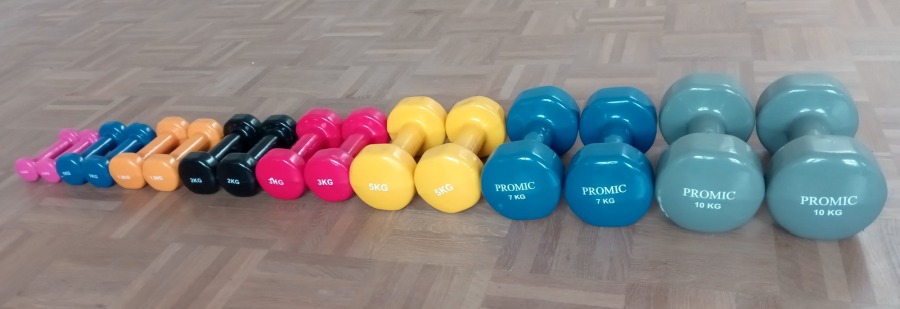
Purpose
Weighing down, exerting force
Explanation
The dumbbell – and the same applies to the weight plate – is certainly a rather exotic yoga prop, but it still has a place in the everyday life of our school. It offers an external weight packed within easy reach and concentrated in a small space.
Examples
Complain
A classic example is a (sufficiently heavy) weight plate placed on the thighs in supta virasana. It should be placed close to the knees for leverage. If the disc has uncomfortably pressing edges, a softness mediator such as a blanket should be placed between them. A good alternative here would be a sandbag, which adapts better to the shape of the thighs and causes less pronounced localised pressure sensations. In ardha supta krouncasana and supta krouncasana, a disc can be leaned against the side of the thigh at an angle, which reduces lateral and upward deviation.
Exertion of force
Useful applications are, for example, those in which the weight plate or dumbbell causes one leg to rotate outwards. To do this, the belt is put on so tightly that the free end points laterally. The weight is then attached to this. This can be done on both sides in symmetrical postures or deliberately on one side if the aim is to achieve an uneven effect in order to work more intensively on a less mobile hip. See the FAQ entry on side discrepancies. One example of this is upavista konasana in a reclined position against the wall. The dumbbell is placed in the sufficiently small loop of a belt so that it cannot slip through. The belt is then wrapped relatively tightly around the foot once or twice and the free end is placed in the performer’s hand to hold on to. Due to the friction of the belt on the foot, the performer hardly needs to exert any force to hold the free end. baddha konasana isanother similar application.
Functional weight training
The following application is not directly related to yoga, namely functional weight training. If you immediately think of bicep curls, you’re not completely wrong – this muscle group tends to be undersupplied in yoga poses. In general, this hardly leads to pronounced imbalances, but arm flexion with dumbbells can achieve therapeutic effects, such as the regenerative training of the palmar flexors in golfer’s elbow, in which the muscles and their tendinous insertions/origins are gently trained with the smallest, only slowly increasing weights and hundreds of repetitions at a time, and their metabolism is stimulated, which promotes healing. Other applications are conceivable in which improved muscular robustness against the demands of work, sport and hobbies is helpful in overcoming disorders and avoiding them in future.
In contrast to disciplines such as weight training, weightlifting or bodybuilding, and also cross-fit, which is quite interesting in terms of its approach, we generally use weights in the range of a small fraction of the one-repetition maximum and perform many repetitions in succession that are not too heavy, usually several dozen. This also applies to strengthening the autochthonous back muscles accompanying the thoracic spine with front raises, which we use for those who complain of the often described complaints in the area next to the spine that usually occur or intensify during the course of the day. A completely different application of an external weight is the following: the transition from the head-up dog position to the head-down dog position should be performed as far as possible using shoulder strength and not hip flexor strength or even momentum. As this type of work and its intensity is not immediately obvious to everyone, we have a significant external weight lifted to the front to illustrate this. This is often a chair, as we have plenty of them. In terms of type and intensity, this is not much different from the work of the shoulders in the transition mentioned above. However, it could also be a suitable dumbbell or weight plate or another external weight. Another important application of external weights in the form of dumbbells is the „therapeutic deadlift“. Depending on the application, significantly different weights are used here. The deadlift strengthens a large part of the muscles on the back of the body, which can provide various valuable services, see the FAQ.
Abutment
A classic application of the dumbbell as an abutment is the malasana forward bend, in which a sufficiently heavy dumbbell is placed in front of the body at a certain, still accessible distance so that the performer can pull themselves further into the forward bend with their arms or hold the posture at all. The use of the dumbbell when rolling up the back from the supine position also falls into the category of resistance rather than „weighting“. If the lumbar spine is not sufficiently mobile, the centre of gravity of the body is so unfavourable that the legs lift off. This can be prevented with a dumbbell. In most cases, the handle is too low to place the dumbbell over the ankle of the straight leg without raising it on both sides. If the pressure of the shin against the handle of the dumbbell is uncomfortable, softness mediators such as patches or a blanket can be used in between.
Chair/bench
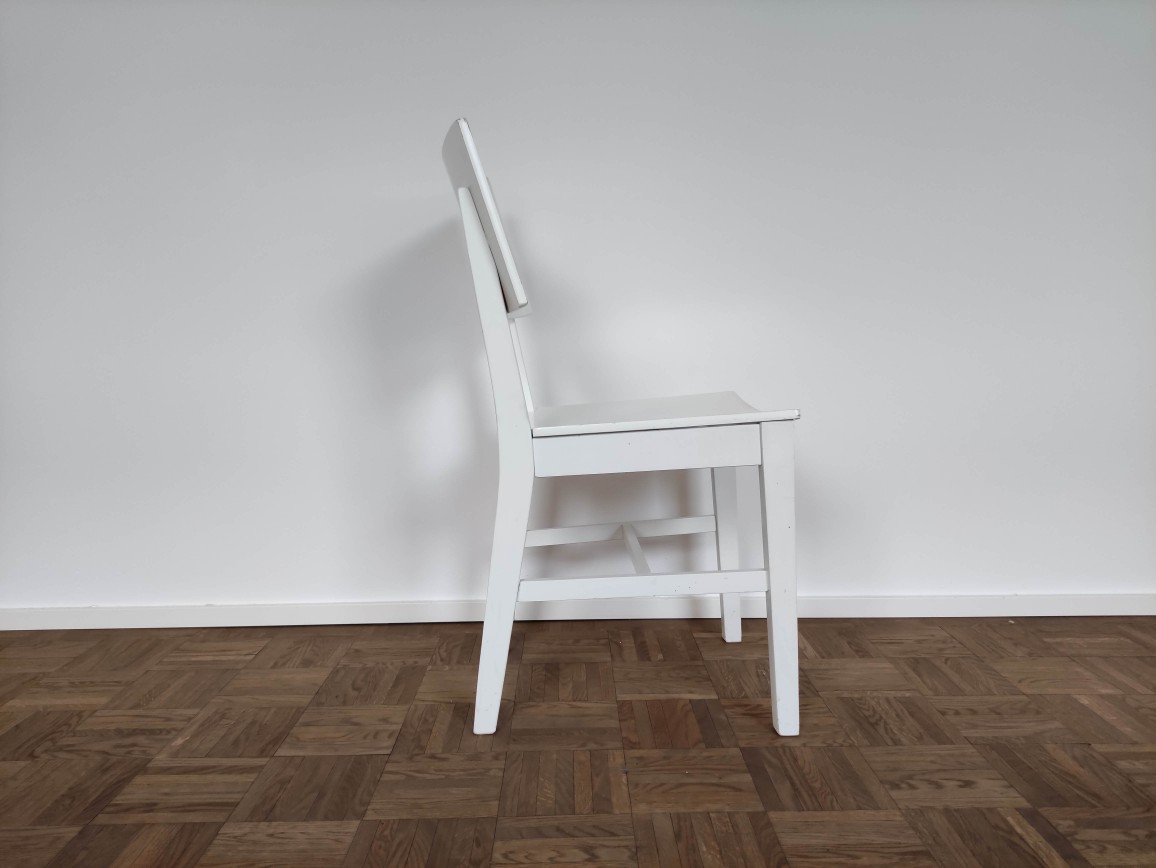
Purpose
Edition, resistance
Explanation
Examples
Resistance e.g. for turning
A classic application of the chair is seated twisting, where the backrest is used as an abutment.
Increased circulation
For example, a well-known application is the shoulder opening on the chair, in which the elbows are placed on the backrest and the performer kneels in front of the chair and lowers the upper body. This enables passive frontal abduction with exorotation of the upper arm, which is almost impossible to perform in any other way without aids. The principle of support (on the seat) is also popular for backbends. The bridge with the feet or hands on a bench also falls into this category. Of course, this could also be a suitable chair. In some cases, it should be noted that cross struts between the feet can be a hindrance. It is also important that the chair or bench is secure and stable. In the case of a bench, supporters can sit on the bench; a chair would probably be best pushed against the wall.
Wall
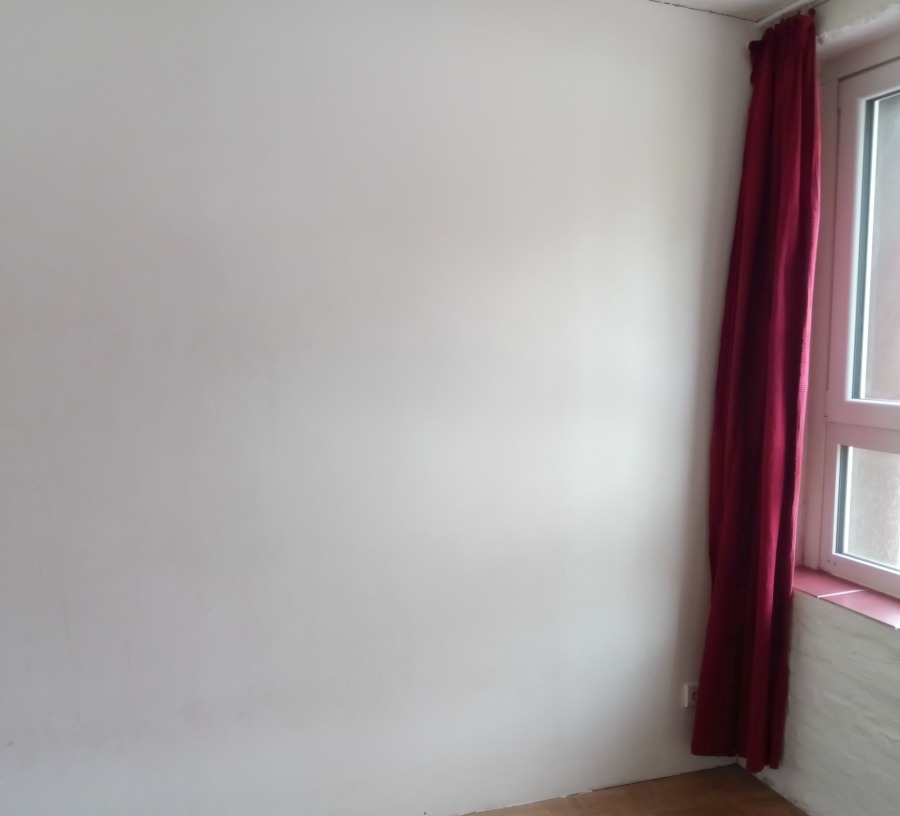
Purpose
Support, resistance
Explanation
The wall provides a reliable vertical support against or on which a wide variety of postures can be practised. In some cases, low friction is helpful, such as in the dvi pada variation of the handstand, but in many cases high friction is required, such as in the right-angled handstand or the hyperbola. In other poses, the body is not fully or partially pressed or leant against the wall, but the wall provides a support against which pressure can be exerted to intensify an otherwise completely down-to-earth pose, for example in the variations of parivrtta trikonasana or parivrtta ardha chandrasana against the wall. The same applies to seated twists against the wall. In ardha ch andrasana, it simply serves as a support against which little or no pressure is exerted. If greater friction is required on the wall than the surface material, patches can be held against it by a supporter or attached with drawing pins or adhesive strips. Similarly, if less friction is required, a blanket can be held against the wall or attached to it. If there is no wall available for the handstand, a piece of wall with a door can of course also be considered if, firstly, the handstand upswing is sufficiently well controlled that the shoulder area does not move too far towards the wall or door and, secondly, it is clear that the heels touch down on a safe, firm and non-sharp-edged area. It should therefore be avoided that the heels strike against an unstable door that opens outwards as well as against a sharp-edged door frame. Incidentally, the expected height of the heel in handstand is approximately the height of the wrists in urdhva hastasana, i.e. standing upright with arms stretched upwards, whereby the slight inclination of the body in leaning handstand is not taken into account.
Examples
Tube
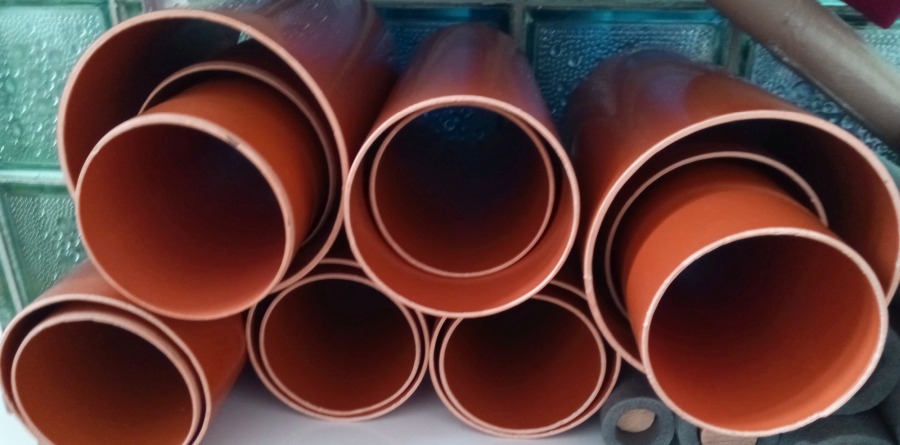
Purpose
Exerting pressure in a special geometry
Explanation
In practice, we use various rollers: larger rollers of different diameters from 10 cm, such as HT tube from the DIY store or a comparable fascia roller, as well as thinner, approx. 8 cm thick rollers with defined compressibility for stretching the trapezius, for example, and occasionally thin fascia rollers against excessive tension in the sole of the foot in cases of cramp tendency or plantar fasciitis and heel spurs.
Examples
larger rolls
The main purpose of these aids is to promote flexibility of the thoracic spine in the direction of extension, which is improved by lying on the roller for longer periods, with the highest line of the roller lying exactly below(caudal) the shoulder blade. The diameter of the roller determines the intensity of the posture. It is often perceived as too hard, which requires a softness mediator such as a blanket between the roller and the back. Rollers can also be used under the knees if supine postures such as savasana cannot be performed or can only be performed with pain or appear contraindicated due to acute or chronic events in the lumbar spine region. They represent a kind of greatly attenuated medical stepped bed pose. In the case of the relaxation pose after practising, viparita karani is of course often a good option.
Thin, defined compressible rolls
These are used in a slightly V-shaped arrangement in a variation of karnapidasana to stretch a tense trapezius, which we use very successfully. We like to use wooden round sticks with a diameter of 3.5 to 3.8 cm with heating pipe insulation around them. The latter provides a certain compressibility and softness that often makes the exercise possible in the first place.
Thin fascia roll
The most important use of the thin fascia roll is to work on the sole of the foot where excessive tension has led to a tendency to cramp or has already led to plantar fasciitis with or without heel spurs. This can be used both preventively and therapeutically and is particularly recommended for people who are on their feet a lot, be it in a professional, hobby or sporting context. Here, the tone of some plantar muscles has often increased significantly, which predisposes to the aforementioned disorders, which, once they have developed, can prove to be very persistent and can hardly be alleviated or remedied without significantly reducing the tension of the sole of the foot. This usually means quite regular application several times a day.
Stick

Purpose
Control of straightness, distance dimension
Explanation
The wooden stick guarantees straightness due to its very limited flexibility. At the same time, it can be used to compare distances when marking a position with the finger. Depending on its thickness, it can also generate pressure when placed between a muscle and the floor.
Examples
Straightness
A classic application is the assessment of the straightness of the spine. If the stick is held against the spinous processes, the lateral deviation of individual vertebrae or sections of the spine can be assessed in the frontal plane. In addition, in the sagittal plane, the ability to lift the thoracic spine kyphosis can be determined and the lumbar spine can be assessed as to whether it is physiologically lordotic, hyperlordotic and less lordotic, steep or even kyphotic. This is utilised in deadlifts, for example, by trying to maintain a distance of about one and a half fingers between the stick and the maximum lumbar spine lordosis. In trikonasana, the stick held against the spine is used to check for lateral flexion of the spine if the first visual impression is not clear enough or if it needs to be checked.
Distance dimension
In upavista konasana performed lying against the wall, you can easily make a general lateral comparison of the mobility of the adductors (here especially the gracilis) with a stick held vertically and placed on the floor, with one finger marking the height of a heel.
Shoulder stand plate
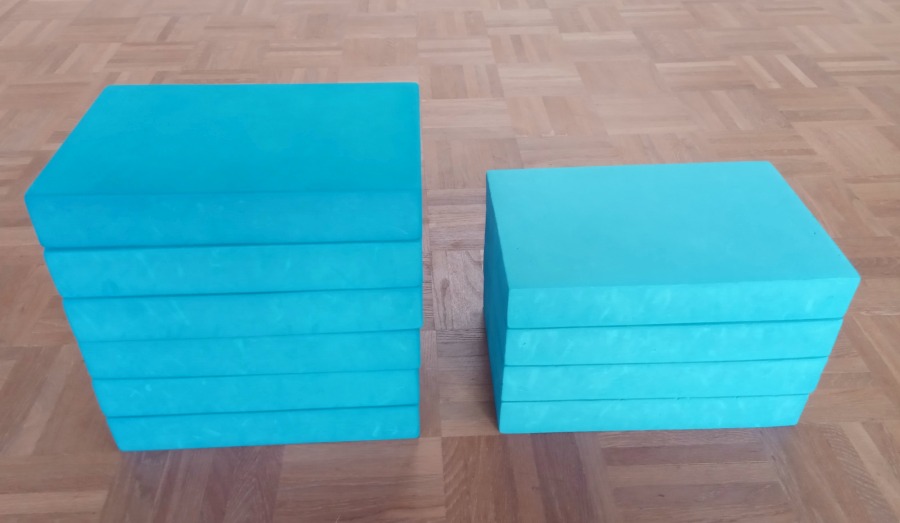
Purpose
Explanation
Shoulder support plates are available in various sizes and strengths. They provide limited compressibility or softness and serve as elevation or spacers.
Examples
Increase
The most well-known application is the eponymous one as a support under the shoulders in sarvangasana. Seated forward bends and seated postures with the upper body and legs stretched out are another popular application for shoulder plates, such as upavista konasana with and without a block between the forearms or janu sirsasana.
Mediator of limited softness and compressibility
They are also frequently used as a mediator of softness and limited compressibility, for example under the carpus when the pressure on the carpus is too uncomfortable in postures such as head-down dog or right-angled handstand.
Spacer
They can also be used as spacers, e.g. to prevent the knee joints from overstretching when working in standing postures against the wall such as uttanasana or partner exercises in which the legs are pressed against the wall, e.g. in the 2nd warrior pose.
Replacement for Klotz
In some postures with an overhead position of the arms, where a tiny moment of careless work can lead to the block falling on the head, such as in upavista konasana with block, the much lighter and softer shoulder stand plate can be the adequate prop.
Mirror

Purpose
Self-control
Explanation
The mirror is used for visual self-control in postures in which it is possible to observe yourself. In addition to the classic yoga poses in which this works well, such as trikonasana or 2nd warrior pose, this also includes deadlifts, in which you try to maintain a straight back (with a physiological lordosis).
Examples
Bolster / Cushion
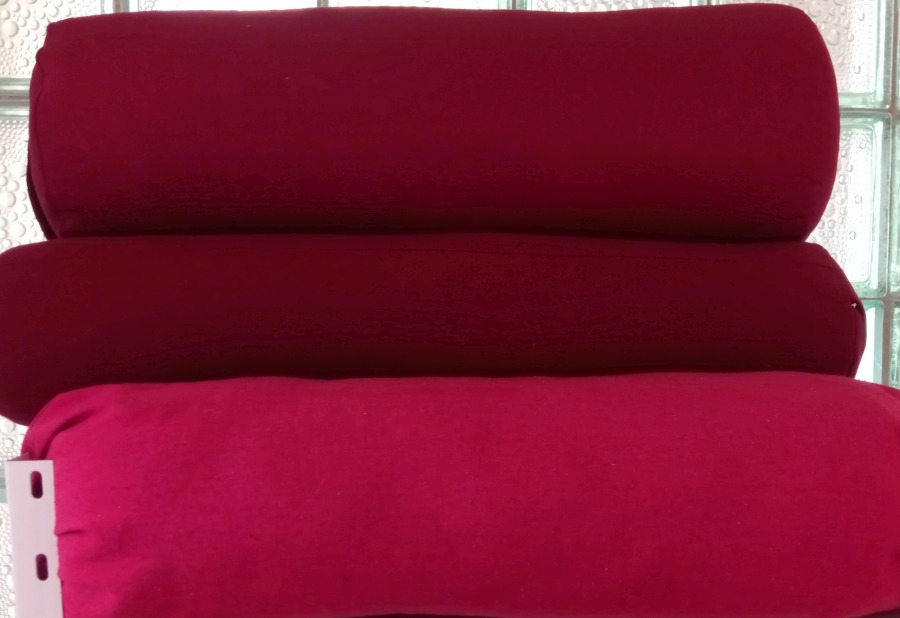
Purpose
soft, significant increase
Explanation
Examples
Raised shelf
Here we naturally think first of the elevated spine in supta virasana or the elevated pelvis in viparita dandasana. Head down dog pose becomes a regenerative pose with the head resting on a bolster.
Supporter
Purpose
All-purpose
Explanation
Humans can do many things that dead, static objects cannot. Whenever an aid is unable to do what is required, be it pressure or traction in one direction or sensitively dosed movement or appropriately and variably adapted pressure that changes over time, the human being comes into play as a superior, intelligent aid capable of perception and communication.
Examples
Window sill

Purpose
size increase
Explanation
The window sill is one of the largest elevations that can be used. Significantly higher than the seat of a chair, it offers the opportunity to place a heel on it and perform a standing hasta padangusthasana as a forward bend, which, when performed with a straight back, is beneficial for people suffering from disc problems. When stretching the back, it offers a valuable alternative exercise by simply resting the palm of the hand on it in the case of wrist problemswhere such extensive dorsiflexion is contraindicated.
Examples
